Thilawa Complaint Management Procedure (TCMP)
(1) Reviewing Complaints Management Procedures currently used by TSEZ
Thilawa Special Economic Zone (SEZ) Complaints Management review was undertaken by JET in Oct, 2017 to identify existing TSEZ complaints management processes. Consultation and engagement with TSMC, Myanmar Japan Thilawa Development Ltd. (MJTD) and community representatives such as Project Affected Community (PACs) and Project Affected Person (PAPs), were included as shown in the following table.
Table: A list of informants during Complaints Review
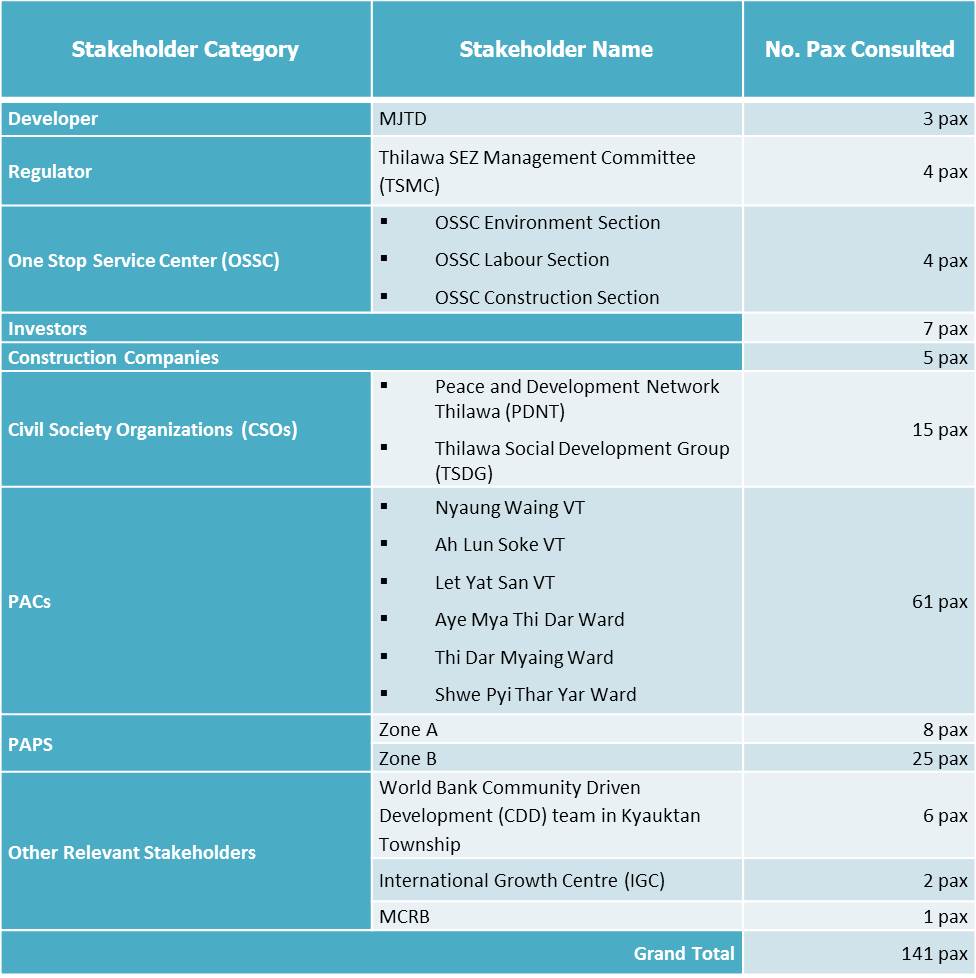

Figure: Percentage of Involvement by each Stakeholder Category during Complaints Review Process
 |
 |
 |
| Meeting with Village Tract level of PAC | Meeting with Zone A PAPs | Meeting with Zone B PAPs |
Figure: Photo of Complaints Review in October , 2017
(2) Designing Thilawa Complaint Management Procedure (TCMP)
An integrated Thilawa Complaint Management Procedure (TCMP) was designed based on the result of complaints review and above key findings of consultation with PAPs, PACs, CSOs and other relevant stakeholders in collaboration with TSMC, MJTD and JICA Expert Team in Nov, 2017 and it builds on, aligns, formalises and integrates existing Thilawa SEZ complaints mechanisms into a single, centralised process. This included development of a TCMP Form as per below and TCMP database to track and monitor complaints.
Thilawa Complaint Management Procedure (TCMP) Complaint Form : TCMP Complaint Form.pdf
Channels to receive complaints, methods of rolling out of TCMP and draft TCM form were discussed with Zone-A and Zone-B PAPs, local communities from PACs, Civil Society Organizations (CSO) and investors through a series of Thilawa Community Coordination (TCC) meetings initiated by MJTD and small group discussion at their places in Nov, 2017 as shown in the following figure. The results of community and stakeholders consultation discussion have been reflected in the TCMP.
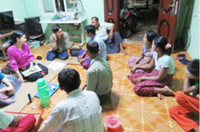 |
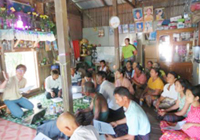 |
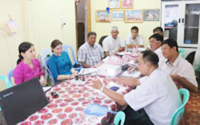 |
| Meeting with Zone B – Phase 1 PAPs | Meeting with residents in Ah Lun Soke Village Tract | Meeting with CSOs |
Figure: Complaints Review
(3) Rollout of TCMP
A series of TCMP rollout to Community, CSOs, investors and Construction Companies during Nov, 2017 to October, 2018 are shown in the following table so that many people know what to do when they have complaints related to TSEZ. A flyer about TCMP was distributed to participants and a presentation about TCMP in Myanmar language was used during rollout of TCMP.
Table: TCMP Rollout Record
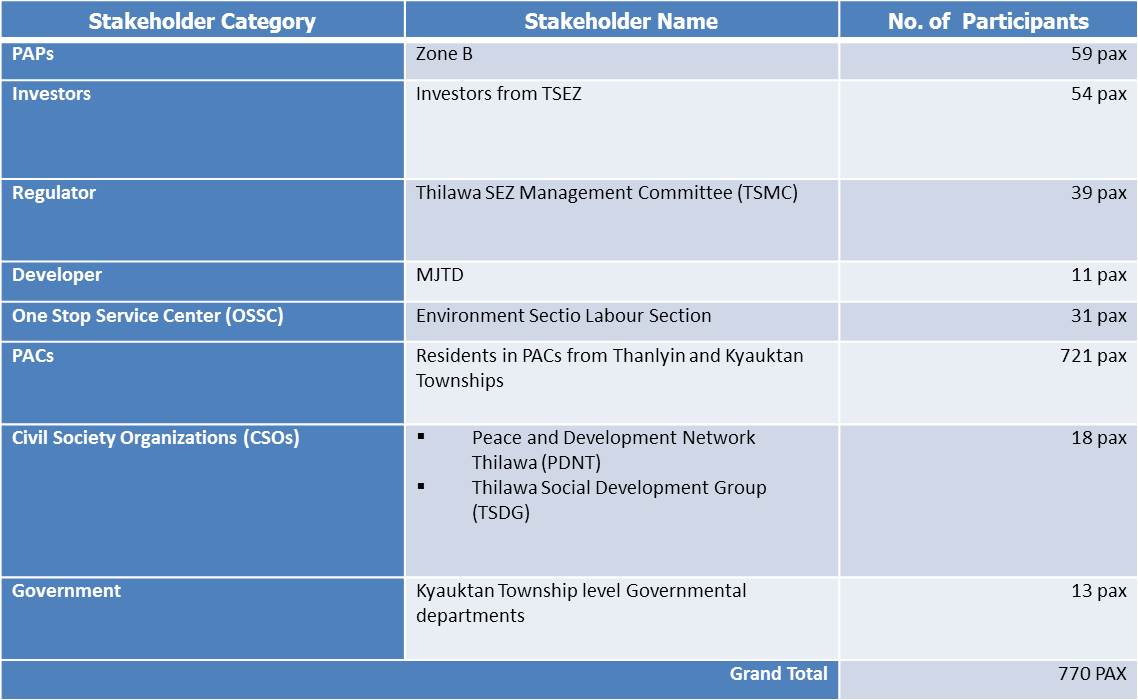
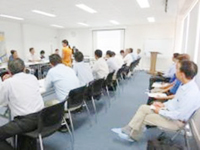 |
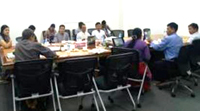 |
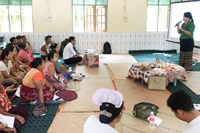 |
| Investors in TSEZ | Kyauktan Township level governmental departments | Shwe Pyauk Vilage Tract |
Figure: Rollout of TCMP
(4) Overall Procedure
Community Relation Team plays an important role in TCMP. CRT is a joint team of TSMC/MJTD and the composition is as per below. The roles of CRT are internal TSEZ coordination team, internal and external ‘face’ of TCMP and administrator of the TCMP with the assistance of support staff.

Figure: Community Relation Team
CRT receives a complaint and acknowledges to a Complainant for receiving a complaint within 7 days after receiving a complaint. CRT then assigns a responsible party based on the type of complaints. Responsible parties are Yangon Regional Government (YRG), TSMC, Township Governmental Departments, related departments in One Stop Service Center (OSSC) such as Labour Section, Environment Section, MJTD, Investors, Construction Company or Main Contractor, etc. The responsible party investigates the complaint and a Complainant can be involved in throughout investigation process. The complaint shall be resolved within 30 days after receiving a complaint. If the complainant accepts a proposed resolution by the responsible party, the agreed actions are implemented. Then the complaint is resolved successfully and the complaint is closed out. If the complainant does not agree to a proposed resolution by the responsible party, it can be escalated to Complaint Review Board (CRB) for further investigation. The overall procedure of TCMP is as per below.
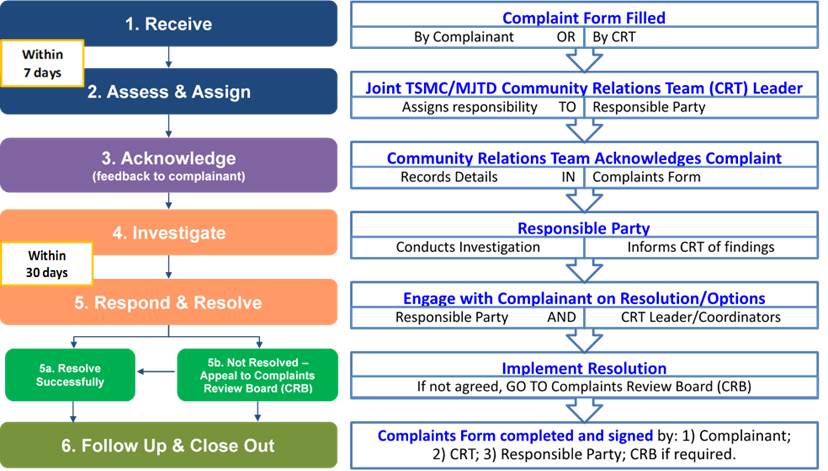
Figure: Overall Procedure of TCMP
(5) Implementation of TCMP
Pilot TCMP implementation using TCMP processes to investigate and resolve complaints has been undertaken since November, 2017. CRT and responsible parties are trying to resolve various types of complaints such as compensation, livelihood restoration, resettlement/relocation site, environment, infrastructure, traffic/transport, employee/worker behaviour, labour (eg., recruitment, salary, working hours/condition, etc) and other in coordinating with Complainants according to TCMP. If TSEZ and the Complainant are unable to agree on a solution, the complaint may be escalaed to the CRB for review and a final decision. Based on the difficulities faced during implementation of TCMP, TCMP design have been updated for smooth and effective operation.
(6) Summary of TCMP Resolution Report
Complaints have been received since November, 2017 and they have been managed with a database.
(i) Complaints by Type of Complaints
The total number of complaints has been categorized with the type of complaints as shown in the following table and figure. Among total number of complaints, compensation related complaint is the most followed by labour related complaints for example payment issue between contractors and sub-contractors, employment issue, ferry car rental person and an investor, etc... The next is environment related issues such as air pollution due to dust, solid waste, odour and flooding. PAPs from relocation site of Zone B – Phase 1 complained about livelihood restoration such as promotion of job opportunities and about resettlement/relocation site such as water supply, road and management of solid waste.
Table: Number of Complaints based on the Type of Complaint
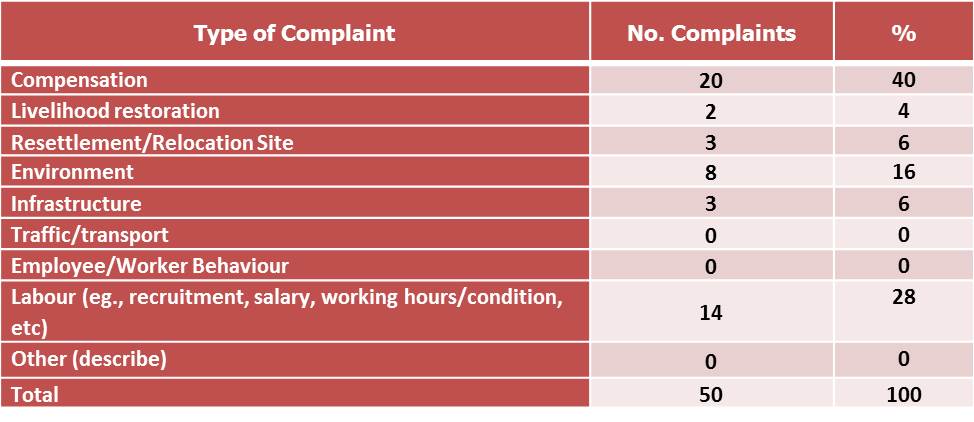
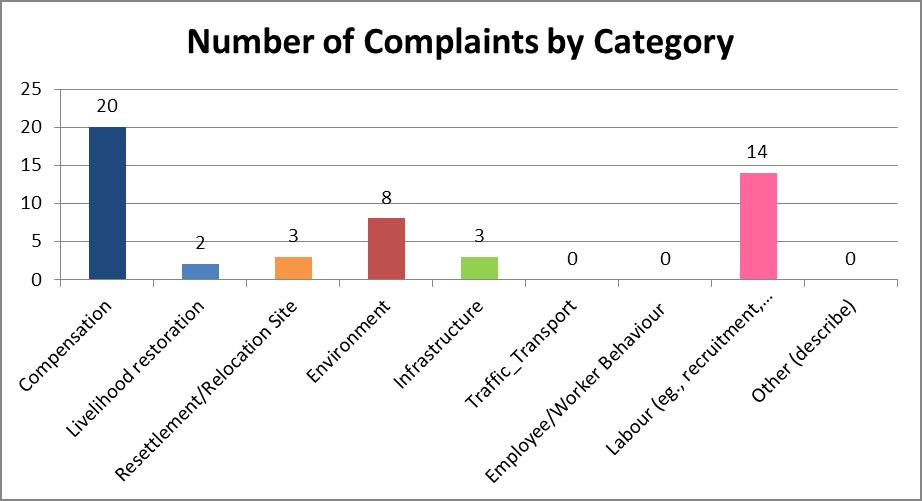
Figure: Complaints by Type of Complaint Category
(ii) Complaints by the Status of Complaints Resolution
The status of complaints resolution is shown in the following table and figure. 70 % of complaints are resolved successfully and closed out, out of 50 numbers of complaints. The percentage of conditionally resolved complaints is 22 %; 82 % are compensation related complaints and remaining are labour related complaints. Conditionally resolved is used when complaints where it has not been possible to reach an agreed resolution, or the complainant is not contactable after two months following the receipt of a complaint, and efforts to trace his/her whereabouts have been unsuccessful. The percentage of under investigation – On track is 6 % and resolution is expected to be readily agreed and resolved. The percentage of under investigation – Concern is 2 % and resolution is difficult to agree and/or Complainant unlikely to agree to a resolution.
Table: Number of Complaints by Resolution Status


Figure: Number of Complaints by Complaints Resolution Status
(iii) Complaints by Complainant Type
Complainant Type is categorized as PAP (Compensated HH), PAC resident, Public, Local employee and other. PAC resident is a person living in the following Village Tract/Township in Thanlyin Township and in Kyauktan Township. Village Tract/Ward not bolded have less impact than those bolded according to the result of rapid assessment of socio-economic impact due to TSEZ by JET in 2016-2017.
Table: Number of Complaints by Resolution Status
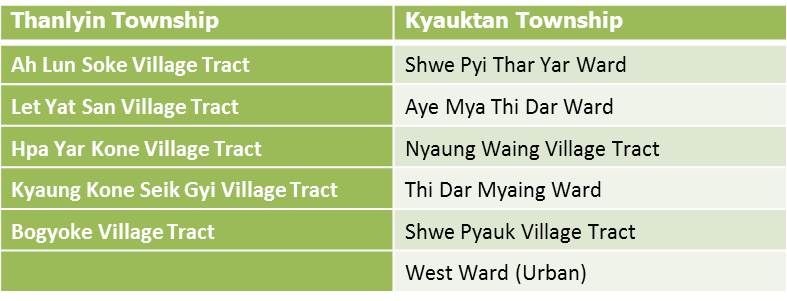
The number of complaints by complainant type is described in the following table and figure. 56 % of complainants are complaints by PAC residents followed by 28 % of complainants by Local Employee at SEZ (compensated HH). The percentage of complainant from PAP (Compensated Household) is 16 %.
Table: Number of Complaints by Resolution Status
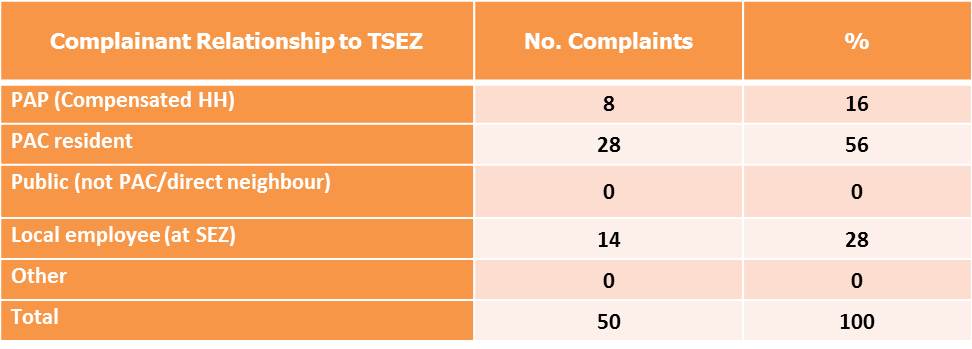
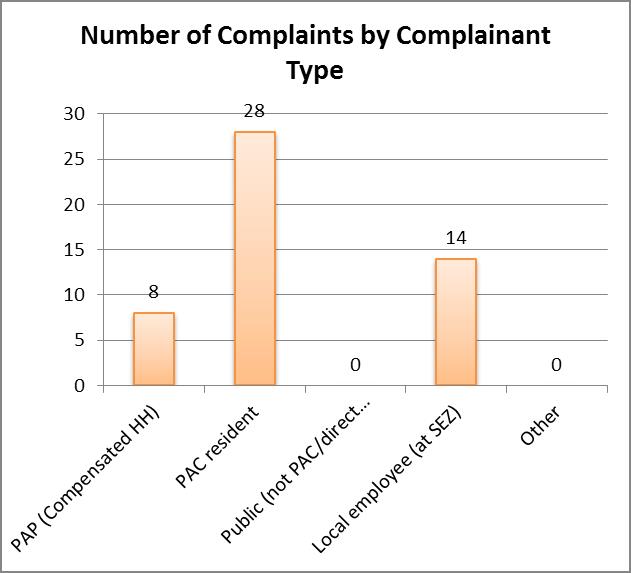
Figure: Number of Complaints by Complaint Type
(iv) Complaints by Location of Complaints happened
The number of complaints by location is described in the following table and figure. The location where the complaints occurred mostly is Thilawa SEZ (Zone A), where most factories are under operation, and the percentage of complaints occurred in PAC is 34 % followed by the complaints occurred in PAC and in Thilawa SEZ (Zone B) where Zone B – Phase 1 and Zone B – Phase 2 are under operation with the percentage of 28 % each. The number of complaints in Relocation Site (Zone B) is 10 %.
Complaints occurred in Thilawa SEZ (Zone A) include mostly labour (e.g. recruitment, salary, working hours/condition, etc) issues such as issues between contractors and sub-contractors, employment issues such as between ferry car rental company and investors, environment issues such as odour and solid waste and infrastructure issue such as damage of road/bridge. Most of the complaints occurred in PAC are related with compensation and others are environment and infrastructure issues. Most of the complaints occurred in Thilawa SEZ (Zone B) are compensation related issue, environmental related issue and infrastructure issue. There exist a few complaints from relocation site (Zone B) about infrastructure at RS and livelihood restoration.
Table: Number of Complaints by Resolution Status

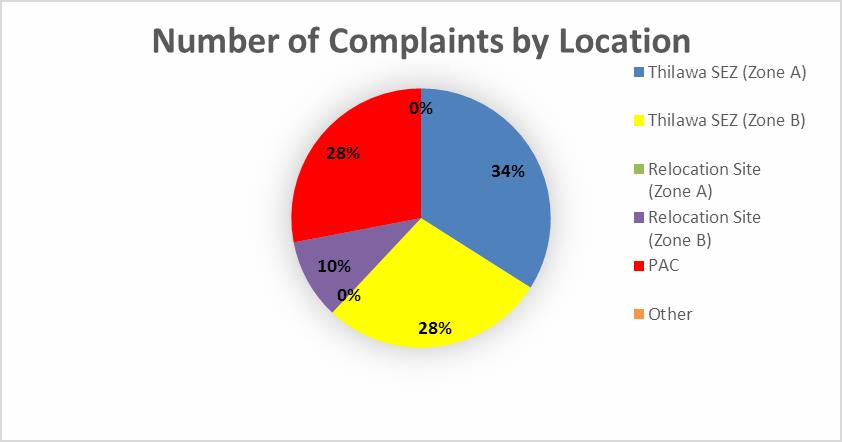
Figure: The number of Complaints by Location
